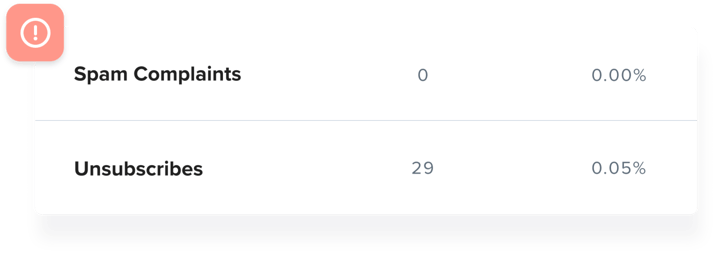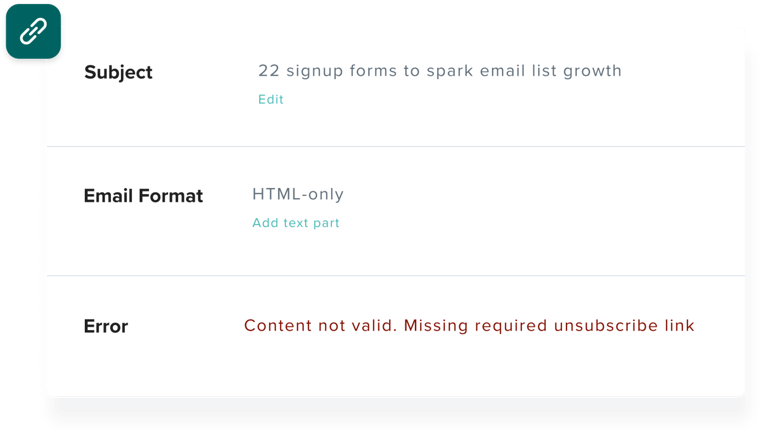Spam Complaint Rate Calculator
Improve Email Deliverability
A high spam complaint rate wreaks havoc on your email deliverability. Spam complaints lead to a high bounce rate and poor email marketing ROI.
Take advantage of our free spam complaint rate reduction calculator and determine how much you can reduce your spam complaints with email validation.
Try it now ->
What is spam complaint rate?
Your email spam complaint rate is the rate at which subscribers report your email content as spam.
Generally, email users report your emails as spam for the following reasons:
- They did not subscribe to your email list
- The email doesn’t have a valid unsubscribe link
- The user previously clicked an unsubscribe link but is still receiving emails
- The user files a spam complaint instead of clicking your unsubscribe link (abuse email)
Understanding when and why you’re receiving these spam complaints is critical, as exceeding the recommended average will hurt your email sender reputation.

What is the average spam complaint rate?
While other email marketing metrics like email bounce rate, email open rate, or email click rate can fluctuate by industry, there’s no room for fluctuation regarding spam complaint rate.
Regardless of industry, the average spam complaint rate to aim for is 0.1% or 1 in 1,000 emails sent.
Other email marketing metrics tell a story about the quality of your content and how it impacts your audience. Spam complaint rates indicate whether or not you’re following the best (and legally necessary) practices to send emails to subscribers only.
High spam complaint rates hurt sender reputation
High spam complaint rates are a significant issue in email marketing.
Internet and email service providers have a lower tolerance for spam. While a 0.1% spam complaint rate is recommended for all industries, each provider may have different thresholds for spam complaints.
If you’re using an email service like Mailchimp, Active Campaign, or Campaign Monitor, they will warn you when a campaign has an unacceptable number of spam complaints.

A high spam complaint rate raises questions about how you obtain your email leads, whether or not you make it easy to unsubscribe, and if you keep a clean email list. It mars your email sender reputation and puts you in the company of malicious spammers and spoofers that ISPs hope to avoid.
A poor sender reputation creates poor email deliverability
Once you’re among a list of bad email actors, expect your email marketing performance to worsen overall.
As your spam complaint rate climbs, you can expect more of your emails to receive the spam flag automatically. Regardless of content quality, ISPs automatically check your email sender reputation and relegate your messages to the spam folder. Depending on the ISP, they may block your content, increasing your email bounce rate.
When emails bounce and hit spam, they go unread, leaving you with lacking email open rates, click rates, and overall unsatisfying email marketing ROI. As you can see in our example from Campaign Monitor above, you’re liable to lose your email account entirely if spam complaints persist.
If you notice your email deliverability declining, using a spam rate checker is essential to get to the root of the issue.
How to use the spam rate calculator
If you’re unsure if your spam complaints are a problem, use our spam complaint rate calculator above.
Here’s how to do it:
- Enter the number of emails you send during a campaign. You can use an exact number from a campaign in question or estimate an average you typically send to your email list.
- Find and enter your spam complaint rate. Though it will differ depending on your provider, this metric is listed as “Spam complaints” or “Abuse.”


- Click Calculate.
Reading your spam rate reduction calculator results
After generating your results, we’ll guide your next steps.
If you achieve the ideal spam complaint rate of 0.1% or less, you’re in good shape. However, we’ll calculate how many more spam complaints you can eliminate by incorporating email list cleaning into your email marketing strategy.
Your spam rate is good. However, there is room for improvement by using ZeroBounce email validation.
Estimated reduced spam complaints
0
A spam complaint rate of 0.1% or lower is ideal.
On the other hand, if you have a high spam complaint rate, we’ll let you know to take action. These figures are based on ZeroBounce’s ability to reduce your spam complaints by as much as 30% with the help of email validation.
Your spam rate is very poor. Your emails risk being flagged and blocked. We highly recommend you use ZeroBounce email validation.
Estimated reduced spam complaints
240
Email validation can quickly reduce your spam complaints
If you find room for improvement after using our spam rate calculator, here are some strategies to reduce your high spam complaint rate.
How to reduce a high spam complaint rate
Use ZeroBounce email validation
The best way to get spam complaints under control fast is through regular email list cleaning. ZeroBounce email validation not only helps you eliminate problematic emails that bounce, but it’s also the only one that can reliably identify spam report abusers.
Users with a habit of issuing spam complaints develop a reputation. When you perform email list cleaning with ZeroBounce, our email validation tool identifies these chronic complainers, known as abuse emails, so that you can delete them from your list. By checking your email before your campaign, you can reduce spam complaints before they happen.
Control your email bounce rate
Email validation also helps with spam complaints by reducing your email bounce rate to 2% or lower. When fewer emails bounce, your email deliverability and sender reputation improve, making you less likely to hit the spam folder.
When your emails hit the inbox, it appears legitimate and trustworthy, making users less likely to report spam. At the very least, uninterested subscribers can easily find your unsubscribe button, preventing any lasting damage to your email marketing efforts.
Use unsubscribe links in email marketing
Continuing the above thought, you must include an unsubscribe link in your emails.
This step is so critical that most email service providers will not allow you to publish a campaign without one. The CAN-SPAM Act dictates that you may only send emails to parties expressing “affirmative consent” while providing an easy, intuitive way to opt out.

Most email service providers will require an unsubscribe link in emails
If your ESP doesn’t provide such a warning, or you’re somehow bypassing the unsubscribe link, reconsider your next steps. Users will report your emails as spam, and some may go as far as to report your company to the FTC.
Double opt-ins help regulate spam complaints
Some users will still publish spam complaints even after email list cleaning, lowering your bounce rate, and improving your email marketing content.
These are usually parties that signed up for a freebie or one-time offer and forget that they subscribed. Rather than clicking unsubscribe, they report you for unsolicited emails.
The best strategy to combat this is to use a double opt-in for all your email registrations. After entering their name and email, users should receive an automatic email stating
- That they’re registering for your email newsletter
- Who the email list belongs to
- What type of content they can expect to receive
This tactic is effective at weeding out abusers and uninterested parties and will play a significant role in helping keep your spam complaint rate low.
Improve your email deliverability with ZeroBounce
A great email service provider can be your spam rate checker, but ZeroBounce helps you eliminate spam complaints.
With email validation, you can rapidly identify invalid emails, spam reporters, catch-all emails, toxic domains, spam traps, and more. Regular email list cleaning is affordable, and we guarantee to lower your bounce rate and improve email deliverability.
Want to see how to eliminate those spam complaints?
Get immediate access to our email validator with 100 free monthly credits. Sign up today - free.
Try these free email deliverability calculators
Frequently asked questions about spam complaint rate
A spam complaint occurs when users mark an email in their inbox, spam, or promotions folder as spam. This complaint indicates to email service providers that the user did not willfully provide their email address and that the sender may be in violation of the CAN-SPAM Act.
Spam complaint rate is the percentage of sent emails that users report as spam. You can find your spam complaint rate by checking your email campaign reports after your campaign is sent.
The average recommended spam complaint rate is 0.1% or 1 in 1,000 emails. This is an ideal, safe threshold, though some email service providers may allow you to go as high as 0.5%.
You can reduce your email spam complaint rate with the following tactics:
- Regular email list cleaning with email validation
- Providing a clear unsubscribe link
- Using double opt-in confirmation
- Keep content relevant to subscribers
You can check your spam complaint rate by reviewing your campaign reports within your email service provider dashboard. You can find this information near your open, click, and bounce rates. Some providers refer to spam complaints as abuse reports.
Our spam complaint rate reduction calculator identifies whether or not you have a safe, poor, or dangerous spam complaint rate. Using our internal metrics, we’ll determine how many spam complaints you can expect to eliminate using ZeroBounce email validation.
